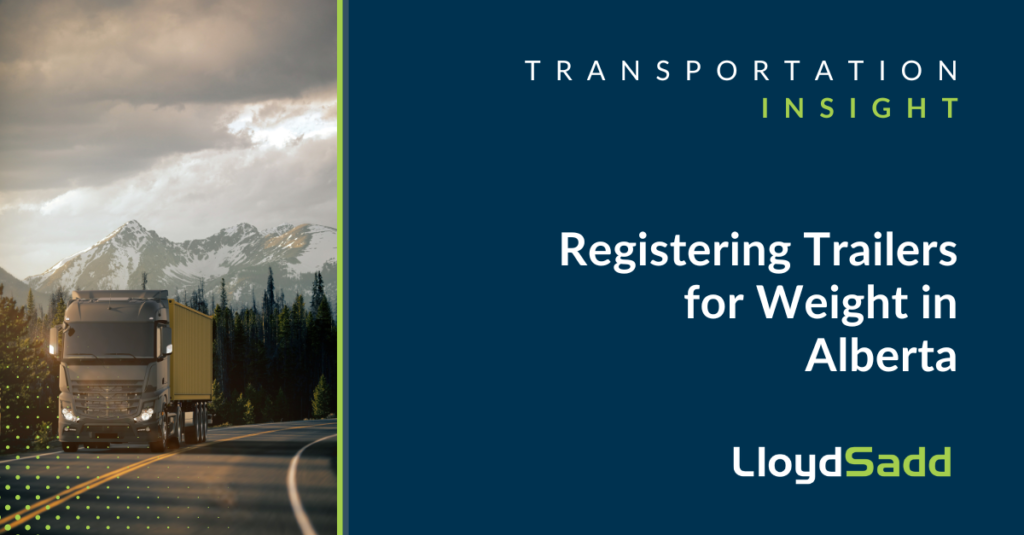Registering Trailers for Weight in Alberta

Written By: Kim Hrushenski, Lloyd Sadd
Navigating the requirement for a Safety Fitness Certificate (SFC) in Alberta has its challenges. Determining if an organization’s vehicles should be registered as provincially or federally regulated is first among those challenges.
According to the Traffic Safety Act “Commercial Vehicle” means a vehicle operated on a highway by or on behalf of a person for the purpose of providing transportation but does not include a private passenger vehicle.
Federal or Provincial?
The first consideration is your area of travel. While there are various permits and the option to dual plate, none speak to the SFC. There are very few real options to travel outside the province of Alberta with a commercial vehicle. The exceptions are limited to the “everything including service within City Limits in Lloydminster AB/SK” and “Highway 17 where the trip starts and ends in Alberta and no services are received or provided”. There is also an exemption (reciprocal) where travel is permitted within 16 kilometers of the AB/SK border; it is understood that this is also conditional on no services being provided or received. The regulator may change a Provincial SFC to a Federal SFC where they identify travel outside the province. The greatest implication if this happens is the move to Federal Hours Of Service regulation.
If your business model means no extra-provincial travel, then a Provincial SFC is appropriate and an SFC is only required if you plan to register for more than 11,794 Kgs. If your business model means travel to another province then a Federal SFC is required for units registered over 4,500 Kgs.
Keep in mind that commercial vehicles (or combination of vehicles) must be registered to, at minimum, the total combined gross weight at the time of attendance at a Vehicle Inspection Stations (VIS) (weigh station/scale). Failing that means an overweight ticket regardless of the manufacturers recommended capacity etc. Failing that may also offer the appearance of negligence if tested in court. Also know that all vehicles weighing more than 4,500Kgs are expected to attend open VIS unless otherwise
directed. While seldom enforced against lighter units, this requirement applies to all commercial vehicles regardless of registration.
Trailers – What and How to Register
Once you have determined the appropriate Safety Fitness Certificate (SFC) for your organization and
understand the regulatory requirements associated, you may be faced with another choice. Alberta allows trailers to be registered for weight. This option has implications for commercial vehicles where the primary power unit is registered between 4,500 Kgs and 11,794 Kgs. The advantage in registering trailers for weight is that there are fewer regulatory requirements associated with units registered between 4,500 Kgs & 11,794 Kgs under a provincial SFC. You may experience this an advantage when not pulling a trailer.
In Summary, the Advantages Include:
- No need to produce documented Daily Vehicle Inspections Report (DVIR)(you must still inspect to ensure safe condition of the vehicle)
- No need to produce Schedule 1 NSC Standard 13 Part 2 No CVIP (annual inspection)
- No documented Safety Program, Driver Training or Driver Files
- No documented Hours Of Service (HOS) training or record keeping (Log Books/ELD’s)
- A power unit that pulls trailers of various weight does not need to be registered to the highest combined weight.
- Registration (trailer) to weight is not a “Continuous” registration and may be cancelled at any time. Doing so draws a pro-rated refund.
The advantage, in general, is a reduction in record keeping obligations while operating under 11,794 Kgs.
Once units are combined these advantages disappear. As an example, the CVI is annual and must be conducted if there is any expectation that combined weights reach 11,794 Kgs, trailers are also subject to CVI if even used in combination over 11,794 Kgs. This leaves HOS & DVIR as the enduring advantages.
In a business model where pulling trailers is only occasional or where there is a variety of trailers pulled then you may consider this option. If so, it must be very well managed to ensure compliance with regulation and defensibility in an event.
To download the insight, click here